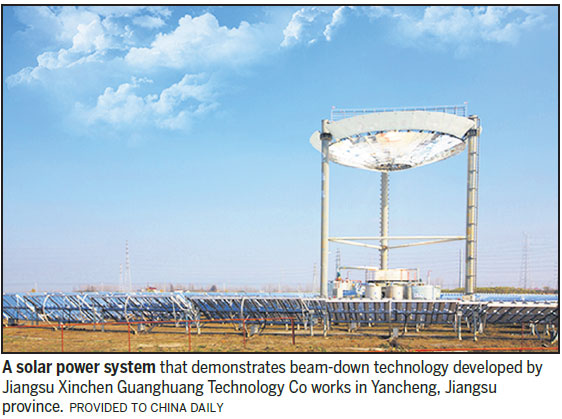When you were a kid, did you ever try to start a fire by using a lens or a curved mirror to concentrate sunlight? Chen Yuda is applying the same principle in a bid to solve China's energy and pollution problems.
This technology, called concentrated solar power, is more experimental than the photovoltaic solar panels now seen on many homes and businesses. A CSP power plant uses mirrors to concentrate sunlight to melt salt; then the molten salt can be used to create steam and power electricity-generating turbines.
China's government is now supporting 20 demonstration projects throughout the country to explore CSP's potential as an additional contributor to a diversified energy strategy.
Chen, who is an electrical engineering graduate from Shanghai's Fudan University, started his career working at Siemens and for an Israeli high-tech company. With partner You Siliang, a Chinese Academy of Sciences PhD who researched photo-thermal science, Chen founded Shanghai Parasol Parasol Renewable Energy Co in 2011 to develop the potential they saw in CSP technology.
"CSP requires long-term research and many experiments before you can finally start building a real station, as tiny problems can lead to failures when we use thousands of special mirrors to reflect light onto a small area, usually about 80 square meters," Chen says.
After years of research, in 2014, he founded a second company, Jiangsu Xinchen Guanghuang Technology Co, which focuses on the real-world integration and implementation of CSP.
CSP projects have been built around the world, notably in Spain and the United States. All these installations aim ground-based mirrors at a single point on a tall tower. This high concentration of power is needed to raise the temperature of the salt to the required melting point.
The big problem with CSP installations is keeping hundreds of mirrors focused accurately on the small area where the salt is melted. Xinchen's innovation is to build a secondary mirror on top of the tower that aims the light from the ground mirrors precisely at the heating point.
"What makes this project special and difficult is that we do a second light reflection, or beam-down. The light is reflected off the ground mirrors to the upper mirror, and then reflected again to the lower heating center," Chen says.
He says the two-mirror technology greatly improves safety. "In many current CSP stations, the top of the center tower, or the heat absorber, malfunctions easily. If the light is too strong, it might burn the surface, and if too weak, the molten salt might solidify and block the tube," Chen says. It is hard and dangerous to repair these problems on a tower high in the air.
Xinchen is now working as part of a consortium to build a 50-megawatt prototype plant in Yumen, Gansu province, that will deploy the two-mirror concept. Started in 2014, the Yumen Xinneng 50-megawatt project has received 1.7 billion yuan ($260 million; 220 million euros; £200 million) of funding and is expected to begin outputting electricity by the end of 2018, Chen says. The project was designed and developed by Xichen and Shanghai Parasol, which now own 15 percent.
This system is also scalable to larger power plants. "With 15 identical modules, we will be able to produce more than 200 million kilowatt-hours of electricity per year." He adds that he hopes that will happen in early 2019.
"We proved that beam-down is possible in an experimental project in 2015 - the first in the world," says Chen, adding that the breakthrough for the technique allowed the Yumen project to be approved as one of the 13th Five-Year Plan (2016-20) CSP demonstration projects.
The National Development and Reform Commission announced that the purchase price for electricity generated by CSP projects is 1.15 yuan per kilowatt-hour, and the price is guaranteed for 25 years.
"With a rate of return on investment of 8 to 9 percent, high payback is promised for investors," Chen says.
CSP has to be deployed in large installations that can be integrated into the national electrical grid, unlike distributed solar panels, which can be widely installed near the point of use. But CSP can produce power at night and during cloudy periods much more easily and cheaply than the expensive batteries needed to store electricity generated by solar panels.
